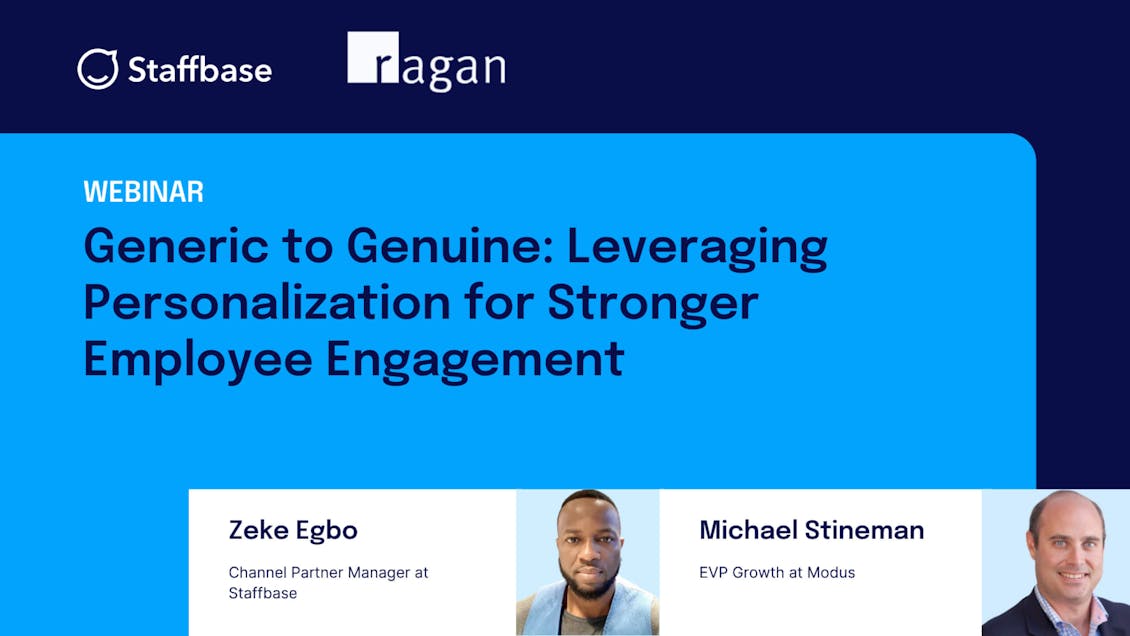5 ways to bring personalization to employee communications

How to go from mass emails to ensuring employees feel seen and heard
In recent years, organizations have pushed to deliver personalized customer experiences. A data-driven approach, customer journey mapping, and omnichannel experiences are all considered table stakes for meeting customers’ needs and exceeding expectations. Meanwhile, less priority has been placed on elevating the experiences of the people behind those customer interactions—the employees.
According to Gallup, employee engagement has dropped to its lowest in over a decade (30%), yet companies with highly engaged workforces outperform their peers with higher earnings per share. A cornerstone of digital workplaces that are succeeding with employee engagement is that they emphasize the importance of communication and listening. But its not enough to have a modern employee intranet or send mass emails — a digital workplace needs strategic, personalized internal communications to drive meaningful engagement.

Generic to Genuine: Leveraging Personalization for Stronger Employee Engagement
In case you missed it, Modus recently joined Ragan Communications and our partner Staffbase for the webinar “Generic to Genuine: Leveraging Personalization for Stronger Employee Engagement.” Host Jon Minnick, Special Projects Manager, Ragan Communications and PR Daily, moderated the conversation with Modus' Michael Stineman, EVP Growth, and Zeke Egbo, Channel Partner Manager at Staffbase, diving into the importance of tailored communications for employees. View the webinar here.
The discussion began by breaking down some of the differences between generic communications and personalized communications. Michael explained that with generic workplace communications, the organization is approaching the message with an inward-facing perspective. Conversely, personalized communications take into account the person who is receiving the message and how they're going to receive it. Personalized messaging could consider preferred format, time zone, and personal information such as job roles, aspirations, interests, and recent achievements.
“Executives often think what motivates them is going to motivate employees, like a data point about a metric we’re trying to hit,” said Michael. “To make it personalized, we can give a special call-out to a group of individuals or this sales unit or this business unit, for really driving the improvement in that metric. Maybe there's even a call-out to a specific person. So that way, again, as the employee receiving this, I can start to understand why should this be motivating to me.”
The conversation quickly shifted into real-world examples and strategies. Michael described how Modus helped one of our clients, a large hospital system, take a journalistic approach to its editorial strategy for employee communications. “They did a highlight once a month of people giving back in the community,” he shared. “They came in did a little video interview with the individual, and I think they had an internal award. But what they really did in terms of promoting that heartfelt story, it really humanized other people and showed that the organization cared.”
Another way to create relevant, personalized employee communications is to include content created by the team members themselves, said Zeke. He shared an example of a Staffbase client, a restaurant group, that has been successful in transforming employees into brand ambassadors and allowing them to post pictures and updates in their Staffbase app. With 97% of employees registered for the app and 50% using it regularly, the client is exceeding its engagement goals in an industry with high turnover.
The discussion also explored how personalized internal communications can lead to significant engagement, improved retention rates, and overall a better sense of connection to the organization — important outcomes especially in the era of remote work.
Of course, whichever editorial strategy your organization chooses for personalized communications, if employees are not engaging with the content, it’s going to feel like a waste of time for everyone. To ensure that personalized communications are resonating, you’ll want to go to the source, both speakers agreed. Collect feedback from team members about what they want and need from their company communications.
Looking for more insights to get started with personalization in employee communications? Here are the top takeaways from the webinar:
- Understand the current state of personalization within your communications. Is your employee data segmented by region or role, for example? Are messages going out that include information that is not relevant to some groups? Do you have the right tools to manage personalized communications? If you have an intranet, analyze which types of content are engaged with or searched for the most, and where your content gaps may be. Are there groups that are not engaging with your intranet, and do you know why?
- Interview various stakeholders to determine which data points and types of information are preferred and most useful. Would some groups rather get SMS text messages or video updates? Are there executive teams that only need high-level alerts?
- Create audience segments that make the most sense for your organization. This may be according to location, role, level of seniority, or interests, for example. Consider how the different segments prefer to receive information, such as field workers who mainly use mobile phones. Make sure to balance the amount of segmentation with your ability to sustainably scale your communications for each group.
- Create a content library of templates that can be customized for each audience. Pre-approved messages and updates that can be tailored to specific audiences will go a long way to making company communications feel personalized while still maintaining consistency. If you have an intranet, consider how you can tailor key experiences within your platform. For example, a welcome screen may look different for a new employee vs. a tenured employee.
- Continuously gather feedback from employees, iterate, and optimize. Before you begin to rollout more personalized communications, decide on which key metrics will determine success for your organization. Gather qualitative and quantitative data to determine where improvements can be made. You may find that you need to tweak how you’ve defined your audiences to ensure that you’re meeting the needs of every individual in your organization.
Your partner for a personalized digital workplace
Looking to get more out of your employee communications with personalized strategies and tools? Reach out to our digital workplace experts to start getting better engagement results and get closer to a workplace where everyone feels seen, heard, and included.

